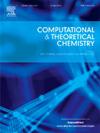Structural stability and thermodynamic properties of (La2O3)n (n = 1–7) clusters system based on density functional theory
IF 3
3区 化学
Q3 CHEMISTRY, PHYSICAL
引用次数: 0
Abstract
The initial configurations of nano‑lanthanum oxide clusters (La2O3)n (n = 1–7) were constructed using a combination of the artificial bee colony algorithm and density functional theory. For the first time, the medium-sized cluster structure with seven lanthanum oxide molecules was established. By optimizing different structures and calculating the vibration frequency, many new configurations different from previous studies were obtained. The average binding energy, second-order difference energy, HOMO-LUMO energy gap, density of states, and molecular orbital properties of the cluster system were analyzed. On this basis, the thermodynamic properties and behavior of nano‑lanthanum oxide clusters under different temperature and molecular number conditions were discussed. The results show that with an increase in the number of molecules, the cluster structure gradually changes from cage-like to spatial ladder-like, and finally to ellipsoid-like. The nanoclusters are stable overall, with relatively higher stability when n = 2,4, and the effect of the lanthanum oxygen atomic orbital on the molecular orbital of the cluster is analyzed. The Cv, Cp, S, and H of (La2O3)n (n = 1–7) clusters increase with temperature, and increase with the number of molecules, while G and Gv decrease with temperature, with changes in the number of molecules greatly affected by E (0 K) and T. The thermodynamic properties of lanthanum oxide clusters with larger molecular numbers are more sensitive to temperature changes. The results provide a theoretical basis for the evolution mechanism of lanthanum oxide clusters-crystals and valuable information for further study of the growth law of rare earth oxide molecular clusters.
基于密度泛函理论的(La2O3)n (n = 1-7)团簇体系的结构稳定性和热力学性质
结合人工蜂群算法和密度泛函理论,构建了纳米氧化镧簇(La2O3)n (n = 1-7)的初始构型。首次建立了由7个氧化镧分子组成的中型团簇结构。通过对不同结构的优化和振动频率的计算,得到了许多不同于以往研究的新构型。分析了聚类体系的平均结合能、二阶差能、HOMO-LUMO能隙、态密度和分子轨道性质。在此基础上,讨论了纳米氧化镧团簇在不同温度和分子数条件下的热力学性质和行为。结果表明,随着分子数的增加,团簇结构逐渐由笼状变为空间阶梯状,最后变为椭球状。纳米团簇总体稳定,当n = 2,4时稳定性相对较高,并分析了镧氧原子轨道对团簇分子轨道的影响。(La2O3)n (n = 1 ~ 7)团簇的Cv、Cp、S和H随温度升高而增大,随分子数增加而增大,G和Gv随温度降低,分子数变化受E (0 K)和t的影响较大。分子数越大的氧化镧团簇热力学性质对温度变化更敏感。研究结果为氧化镧团簇晶体的演化机理提供了理论依据,为进一步研究氧化稀土分子团簇的生长规律提供了有价值的信息。
本文章由计算机程序翻译,如有差异,请以英文原文为准。
求助全文
约1分钟内获得全文
求助全文
来源期刊

Computational and Theoretical Chemistry
CHEMISTRY, PHYSICAL-
CiteScore
4.20
自引率
10.70%
发文量
331
审稿时长
31 days
期刊介绍:
Computational and Theoretical Chemistry publishes high quality, original reports of significance in computational and theoretical chemistry including those that deal with problems of structure, properties, energetics, weak interactions, reaction mechanisms, catalysis, and reaction rates involving atoms, molecules, clusters, surfaces, and bulk matter.
 求助内容:
求助内容: 应助结果提醒方式:
应助结果提醒方式:


